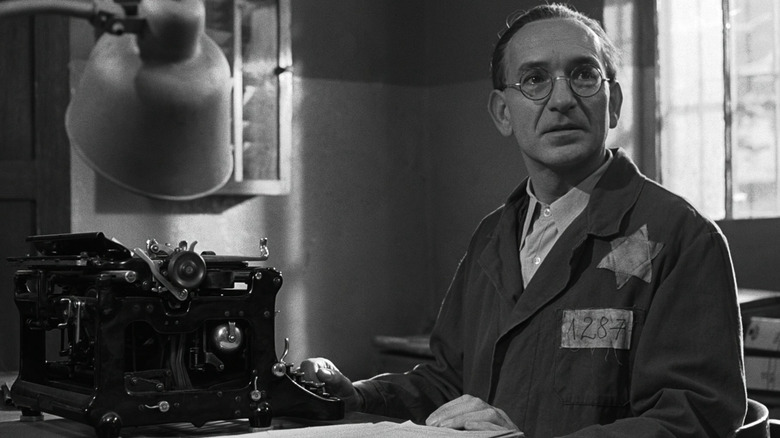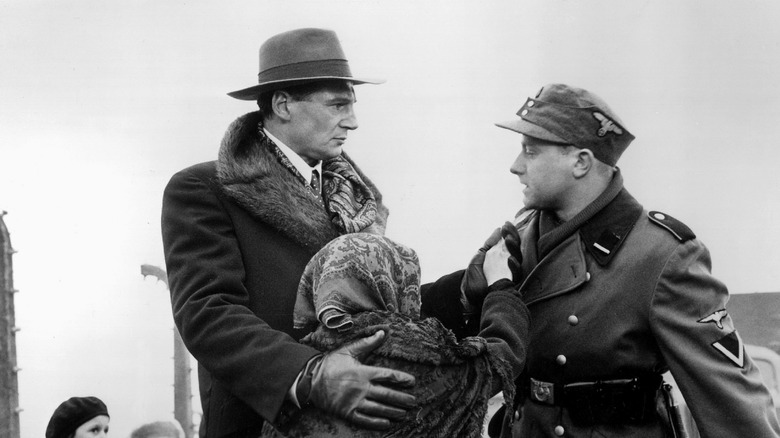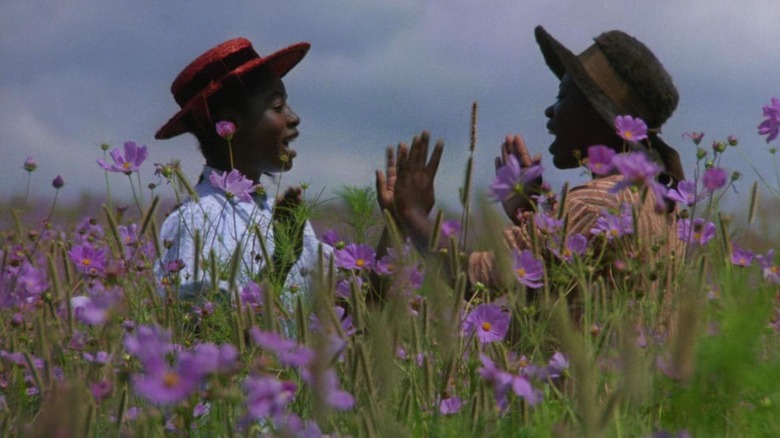Universal Tried To Make A Big Change To Schindler's List, But Steven Spielberg Refused
1993 was a year of change for filmmaker Steven Spielberg. On June 11, the director's dinosaur thriller "Jurassic Park" was released, making huge amounts of money and, eventually, becoming one of the biggest blockbusters of the decade. On December 15, the director's soul-rattling Holocaust drama "Schindler's List" was released, inviting a wave of praise and astonishment from audiences. It went on to win seven Academy Awards, including Best Picture.
Up until June of 1993, Spielberg was perhaps best known for his action blockbusters and adventure films ("The Color Purple" and "Empire of the Sun" notwithstanding). After December 1993, Spielberg would become seemingly less interested in genre films and far more interested in movies aimed squarely at adults. He didn't seem terribly invested in his 1997 sequel to "Jurassic Park," titled "The Lost World," and, indeed, Spielberg's adventure films released since then have all felt distant and automatic, especially when compared to his more politically-bent historical dramas like "Munich," "Lincoln," and "The Post." It seems that he grew up as both a filmmaker and a person.
A lot of this maturity may have come from his insistence that "Schindler's List" be made the way he wanted it. He was passionate about the material and wanted to tell the story of Oskar Schindler in a very specific way. Notably, he wanted his film to be shot in black-and-white (by the terrific cinematographer Janusz Kamiński). In a recent oral history printed in The Hollywood Reporter, Spielberg recalled butting heads with Universal over whether or not he would be allowed to shoot "Schindler's List" in monochrome. If the studio had had its way, "Schindler's List" would have been in color.
That time Tom Pollock was wrong
The head of Universal at the time was the late Tom Pollock, a superstar executive who oversaw the release of 200 movies that collectively earned over $10 billion at the box office. Seven of the films he oversaw were nominated for Best Picture. He knew the business. When dealing with Spielberg, however, Pollock was hesitant. For one, Pollock was (reasonably) uncomfortable with the idea that Spielberg would be working on post-production on "Jurassic Park" and pre-production on "Schindler's List" at the same time. Spielberg's turnaround was so fast that it was necessary to overlap the two productions. Luckily, George Lucas stepped in to finish the mixing on "Jurassic Park" so Spielberg could work on "Schindler's List."
In addition, Pollock didn't like Spielberg's plan to make "Schindler's List" in black-and-white ... and he was upfront about it. Spielberg recalled his interactions with Pollock:
"Tom found out that I'd decided to shoot the film in black-and-white. He was really upset about that. He called me and said, 'It's a challenging piece of business by itself. The subject matter alone doesn't guarantee any return.' Because they had agreed to put up $20 million to make the film. 'But if you make it in black-and-white, it's going to give us no chance to be able to recoup our investment.'"
One cannot fault Pollock for thinking of the grosses on a film before artistic integrity; that was his job.
Spielberg, however, was adamant, having learned a lesson from some of his earlier historical dramas. Namely, shooting a film in color — especially when working with talented cinematographers — makes the drama too aesthetically warm. "Schindler's List," he felt, shouldn't have the opportunity to look beautiful.
The color of The Color Purple
Speilberg admitted that he wanted to shoot his 1985 drama "The Color Purple," based on the book by Alice Walker, in black-and-white. When the film came out, some critics lambasted Spielberg for romanticizing the film's grim subject matter. Spielberg continued:
"I said, 'If I make it in color, it's going to do what shooting "Color Purple" in color did to "Color Purple."' 'Color Purple' should've been in black-and-white. I was accused of beautifying 'Color Purple' because it had such a bright palette for such a dark subject. I said, 'Except for George Stevens' footage of the liberation of Dachau, everything that anyone's ever been exposed to about the Shoah has been in black-and-white. I will not colorize the Holocaust.'"
In 1945, filmmaker George Stevens directed a 60-minute documentary called simply "Nazi Concentration Camps." It looked at the death in the camps with a bare eye, revealing the true horrors of what went on inside. Later, Stevens' film was used as evidence at the Nuremberg trials. Some of the footage of the liberation of Dachau was in color. Spielberg didn't want any sort of glamor or warmth to be part of his Holocaust drama.
Pollock, still trying to be diplomatic, asked Spielberg "Well, why don't you shoot the film in color, you can release it in black-and-white, but we will sell the cassettes in color?" He wanted the black-and-white version of "Schindler's List" to be a "special edition" on VHS. Spielberg said no. He got his way.
Given the attention given to films like "Schindler's List," "The Artist," "Belfast," "Mank," "Roma," "Nebraska," "Cold War," "Francis Ha," "Good Night and Good Luck," and "Sin City," a studio executive's fear of black-and-white is likely less pronounced in 2024.


